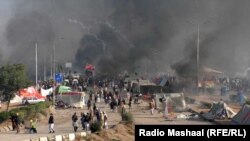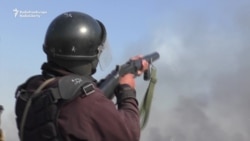ISLAMABAD -- Islamist party activists have clashed with security forces for a second day on the outskirts of Islamabad, burning vehicles before withdrawing to a protest camp they have maintained for nearly three weeks.
The violence on November 26 came a day after clashes between the hard-line Islamist protesters and Pakistani security forces killed at least six people, and injured more than 200 others.
At least one police officer was killed by stone-throwing demonstrators and more than 80 police were injured in the November 25 clashes.
The violence prompted Pakistan's Interior Ministry late on November 25 to authorize the deployment of “sufficient troops” from the country’s military to "control law and order" in the city until further notice.
Reports said army troops were meant to secure sensitive installations, diplomatic enclaves, as well as the offices of the judiciary, parliament, presidency, prime minister, and Foreign Ministry.
But although police and paramilitary forces surrounded the protest camp in the Faizabad District, there were no army troops at the scene of the demonstration early on November 26.
"We will move when we have orders," Police Superintendent Amir Niazi said early on November 26. "What the protesters did yesterday was in no means was lawful. They attacked our forces."
Larger Numbers
Shortly after dawn on November 26, smoke could be seen billowing from the charred remains on the road of a car and three motorcycles that had been torched by demonstrators, who then retreated back to their nearby protest camp.
About 2,000 protesters have maintained the camp since November 6, blocking a main road into Islamabad that is used by thousands of commuters coming from the nearby garrison city of Rawalpindi.
But early on November 26, it was clear that the protest rally had grown to even larger numbers, including several thousand members of the Tehreek-e Labaik Ya Rasool Allah party.
Protests also have spread to nine other cities and towns, including Pakistan’s southern port city of Karachi.
RFE/RL's Radio Mashaal reported on November 26 that protesters also had entered Islamabad's I-8 sector -- an area bordering Rawalpindi.
Another religious leader Tahirul Qadri, who protested for months against the government in 2014, was due to arrive in Pakistan on November 26 from his current base in Canada. Qadri announced on November 25 that he plans to address a rally in Lahore.
Broadcasting Restrictions
Meanwhile, journalists and their unions on November 26 were demanding that the government rescind an order that prevents private television channels from broadcasting coverage of the protests in Islamabad and other cities via cable.
The order on November 25 was issued by Pakistan's Electronic Media Regulatory Authority (PEMRA).
The private Pakistan Broadcasting Association said the government should order cable service providers to restart television channels and their coverage of the protests.
Saiful Islam Saifi, the head of the Journalists' Union in Peshawar, said PEMRA's order was "a restriction on the freedom of expression."
Speaking in an interview with RFE/RL's Radio Mashaal on November 26, Saifi demanded that the government allow media to report and broadcast freely.
Separately, Pakistan's telecom authority also banned access to social media networks like Twitter, YouTube, and Dailymotion in an attempt to prevent coverage of the standoff between the Islamist protesters and authorities.
Police on November 25 fought running battles with the Islamists, who are demanding the resignation of Pakistani Law Minister Zahid Hamidover over what they claim was a blasphemous parliamentary bill to amend the country’s election laws.
Despite the operation involving 8,500 elite police and paramilitary troops in riot gear -- and the use of tear gas and batons by authorities -- the security forces on November 25 were unable disperse those at the protest camp.
With reporting by Reuters, AP, AFP, and BBC









